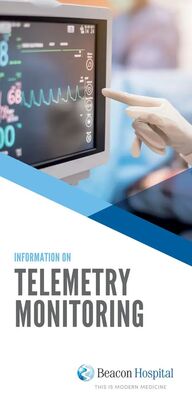
Return to flip book view
BACK PAGE FRONT PAGE FOLD 17 07 FOLD 14 10 2019 FOLD 1 FOLD PAGE 5 Beacon Hospital Telemetry DL PQ2 BOLDER pdf What Activities Are Safe For Me To Do Stay active Keep walking and moving around if this is OK with your doctor and nurse practitioner Telemetry should not make you move less or be less active than usual Check in with the nurse Before you take a shower Before you disconnect the telemetry Before you leave the unit If you have a test and the wires need to be removed If you notice that one of the electrodes has fallen off If you notice that your monitor is beeping Put the telemetry unit into the pouch your nurse gave you Wear this pouch around your neck to protect the telemetry unit and to keep the sticky pads in the right place If your hospital gown has pockets you can keep the telemetry unit in the pocket For some people the sticky pads can irritate the skin Tell your nurse if you are itchy or notice any redness raised bumpy skin or open skin areas on your chest We have sticky pads for sensitive skin What Activities Are Not Safe Don t leave the unit or your room without letting your nurse know INFORMATION ON It is very important that you have the monitor on at all times TELEMETRY MONITORING Don t take off your telemetry wires or sticky pads Don t get your telemetry monitor wet Don t leave your telemetry monitor on the hospital bed wrapped in the Bedsheets IMPORTANT If you leave the unit we will not be able to check your heart or respond quickly to changes in your heart rhythm This could be very dangerous and even life threatening Beacon Hospital Sandyford Dublin 18 D18 AK68 CALL YOUR NURSE RIGHT AWAY IF YOU FEEL Chest pain Discomfort Nausea Sweating Dizziness Fast heartbeat Shortness of breath Generally feeling sick Tel 01 293 6600 www beaconhospital ie FOLD FOLD FOLD FOLD THIS IS MODERN MEDICINE
PAGE 4 FOLD PAGE 3 17 07 FOLD 14 10 2019 FOLD 2 FOLD PAGE 2 Beacon Hospital Telemetry DL PQ2 BOLDER pdf INFORMATION ON TELEMETRY MONITORING What Is Telemetry Monitoring What Can I Expect When you are admitted to the hospital your doctor While you are wearing the telemetry monitor or nurse practitioner may ask you to begin telemetry monitoring Telemetry is a way for your health care team to check your heart rate and rhythm while you are in the hospital How Does It Work It does not fix any of your heart problems It does not check your blood pressure or shock your heart It will not cause you pain What Happens During Telemetry Monitoring These are the steps you can expect Sticky pads electrodes are placed on your chest If you have hair on your chest your nurse may need to shave and clean the area to make sure the pads stick to your skin Why Do I Need It The telemetry monitor has 5 wires that are connected to sticker pads called electrodes You may need telemetry monitoring if you 5 wires are attached to your chest have a certain type of heart or lung disease have had irregular heart rhythms in the past are taking medications that may cause changes in heart rhythms The telemetry unit is programmed to alarm or let the nurse know if there are any changes in your heart rhythm You will not hear the alarm It can only be heard at the monitoring station A member of your health care team puts the pads in different places on your chest These pads and wires pick up signals from your heart and send them to the telemetry unit The unit changes these signals into a picture of your heart rhythm Nurses watch the pictures of your heart rhythm from a monitoring station 24 hours a day have had fainting spells that are caused by a heart problem have had a pacemaker or defibrillator As long as you are wearing the unit the nurses can see if there is a change in your heart This information helps your health care team plan your medications and treatments while you are in the hospital have had any heart surgery or procedure At times the unit can send an alarm for other reasons but the nurse may still come to check on you Some examples of when the telemetry unit may send an alarm include How Long Will I Need To Wear It FOLD FOLD FOLD FOLD Your doctor or nurse practitioner will let you know how long you need telemetry monitoring Ask your nurse doctor or nurse practitioner if you have any questions Repeated moving of the wires for example when you walk or brush your teeth Disconnected wire or electrode Low battery Being too far from the monitoring station so the nurses can no longer see your heart pictures